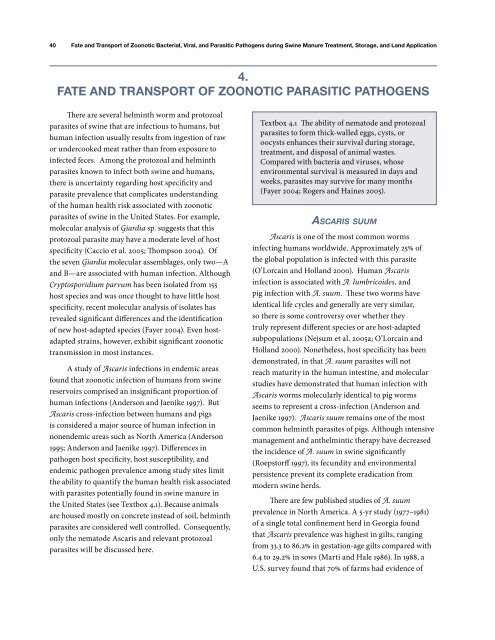Fate and Transport of Zoonotic Bacterial, Viral, and - The Pork Store ...
Fate and Transport of Zoonotic Bacterial, Viral, and - The Pork Store ...
Fate and Transport of Zoonotic Bacterial, Viral, and - The Pork Store ...
Create successful ePaper yourself
Turn your PDF publications into a flip-book with our unique Google optimized e-Paper software.
40<br />
<strong>Fate</strong> <strong>and</strong> <strong>Transport</strong> <strong>of</strong> <strong>Zoonotic</strong> <strong>Bacterial</strong>, <strong>Viral</strong>, <strong>and</strong> Parasitic Pathogens during Swine Manure Treatment, Storage, <strong>and</strong> L<strong>and</strong> Application<br />
4.<br />
FATe AND TrANSPOrT OF ZOONOTIC PArASITIC PAThOgeNS<br />
<strong>The</strong>re are several helminth worm <strong>and</strong> protozoal<br />
parasites <strong>of</strong> swine that are infectious to humans, but<br />
human infection usually results from ingestion <strong>of</strong> raw<br />
or undercooked meat rather than from exposure to<br />
infected feces. Among the protozoal <strong>and</strong> helminth<br />
parasites known to infect both swine <strong>and</strong> humans,<br />
there is uncertainty regarding host specificity <strong>and</strong><br />
parasite prevalence that complicates underst<strong>and</strong>ing<br />
<strong>of</strong> the human health risk associated with zoonotic<br />
parasites <strong>of</strong> swine in the United States. For example,<br />
molecular analysis <strong>of</strong> Giardia sp. suggests that this<br />
protozoal parasite may have a moderate level <strong>of</strong> host<br />
specificity (Caccio et al. 2005; Thompson 2004). Of<br />
the seven Giardia molecular assemblages, only two—A<br />
<strong>and</strong> B—are associated with human infection. Although<br />
Cryptosporidium parvum has been isolated from 155<br />
host species <strong>and</strong> was once thought to have little host<br />
specificity, recent molecular analysis <strong>of</strong> isolates has<br />
revealed significant differences <strong>and</strong> the identification<br />
<strong>of</strong> new host-adapted species (Fayer 2004). Even hostadapted<br />
strains, however, exhibit significant zoonotic<br />
transmission in most instances.<br />
A study <strong>of</strong> Ascaris infections in endemic areas<br />
found that zoonotic infection <strong>of</strong> humans from swine<br />
reservoirs comprised an insignificant proportion <strong>of</strong><br />
human infections (Anderson <strong>and</strong> Jaenike 1997). But<br />
Ascaris cross-infection between humans <strong>and</strong> pigs<br />
is considered a major source <strong>of</strong> human infection in<br />
nonendemic areas such as North America (Anderson<br />
1995; Anderson <strong>and</strong> Jaenike 1997). Differences in<br />
pathogen host specificity, host susceptibility, <strong>and</strong><br />
endemic pathogen prevalence among study sites limit<br />
the ability to quantify the human health risk associated<br />
with parasites potentially found in swine manure in<br />
the United States (see Textbox 4.1). Because animals<br />
are housed mostly on concrete instead <strong>of</strong> soil, helminth<br />
parasites are considered well controlled. Consequently,<br />
only the nematode Ascaris <strong>and</strong> relevant protozoal<br />
parasites will be discussed here.<br />
Textbox 4.1 <strong>The</strong> ability <strong>of</strong> nematode <strong>and</strong> protozoal<br />
parasites to form thick-walled eggs, cysts, or<br />
oocysts enhances their survival during storage,<br />
treatment, <strong>and</strong> disposal <strong>of</strong> animal wastes.<br />
Compared with bacteria <strong>and</strong> viruses, whose<br />
environmental survival is measured in days <strong>and</strong><br />
weeks, parasites may survive for many months<br />
(Fayer 2004; Rogers <strong>and</strong> Haines 2005).<br />
As c A r i s s u u m<br />
Ascaris is one <strong>of</strong> the most common worms<br />
infecting humans worldwide. Approximately 25% <strong>of</strong><br />
the global population is infected with this parasite<br />
(O’Lorcain <strong>and</strong> Holl<strong>and</strong> 2000). Human Ascaris<br />
infection is associated with A. lumbricoides, <strong>and</strong><br />
pig infection with A. suum. <strong>The</strong>se two worms have<br />
identical life cycles <strong>and</strong> generally are very similar,<br />
so there is some controversy over whether they<br />
truly represent different species or are host-adapted<br />
subpopulations (Nejsum et al. 2005a; O’Lorcain <strong>and</strong><br />
Holl<strong>and</strong> 2000). Nonetheless, host specificity has been<br />
demonstrated, in that A. suum parasites will not<br />
reach maturity in the human intestine, <strong>and</strong> molecular<br />
studies have demonstrated that human infection with<br />
Ascaris worms molecularly identical to pig worms<br />
seems to represent a cross-infection (Anderson <strong>and</strong><br />
Jaenike 1997). Ascaris suum remains one <strong>of</strong> the most<br />
common helminth parasites <strong>of</strong> pigs. Although intensive<br />
management <strong>and</strong> anthelmintic therapy have decreased<br />
the incidence <strong>of</strong> A. suum in swine significantly<br />
(Roepstorff 1997), its fecundity <strong>and</strong> environmental<br />
persistence prevent its complete eradication from<br />
modern swine herds.<br />
<strong>The</strong>re are few published studies <strong>of</strong> A. suum<br />
prevalence in North America. A 5-yr study (1977–1981)<br />
<strong>of</strong> a single total confinement herd in Georgia found<br />
that Ascaris prevalence was highest in gilts, ranging<br />
from 33.3 to 86.2% in gestation-age gilts compared with<br />
6.4 to 29.2% in sows (Marti <strong>and</strong> Hale 1986). In 1988, a<br />
U.S. survey found that 70% <strong>of</strong> farms had evidence <strong>of</strong>


